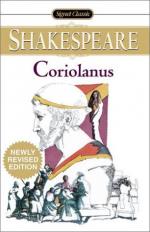|
This section contains 10,291 words (approx. 35 pages at 300 words per page) |

|
SOURCE: "Wound-man: Coriolanus, Gender, and the Theatrical Construction of Interiority," in Feminist Readings of Early Modern Culture, edited by Valerie Traub, M. Lindsay Kaplan, and Dympna Callaghan, Cambridge University Press, 1996, pp. 93-118.
In the essay that follows, Marshall examines the ways in which the figure of Coriolanus challenges the ideal of the impenetrable body as a necessary condition of masculinity.
Feminists have frequently pointed out the unhappy ramifications for women of Cartesian dualism. Inscribed within the separation of mind and body is a further implicit division based upon gender, since the traditional association links men with the mind, while women's more visible reproductive capacities have enforced their identification with the lower realm of the body or bodiliness. So deeply engrained is the dualistic mode of thinking that its traces appear virtually everywhere, not least in our critical practice. Those who would challenge traditional sex and gender systems have...
|
This section contains 10,291 words (approx. 35 pages at 300 words per page) |

|


